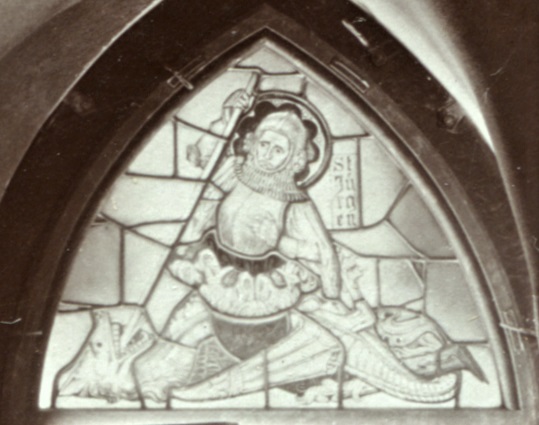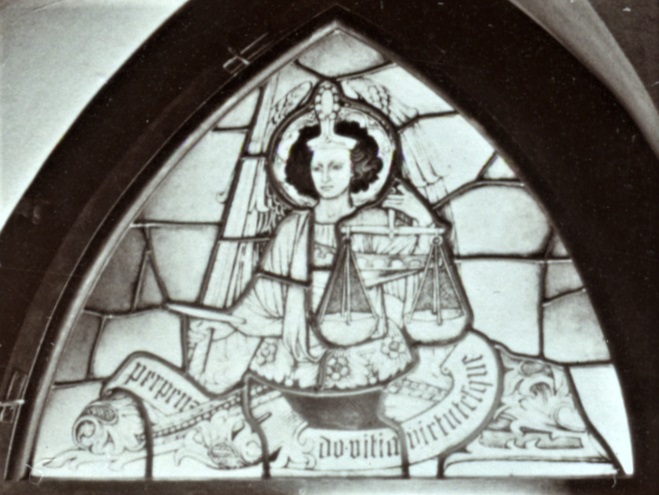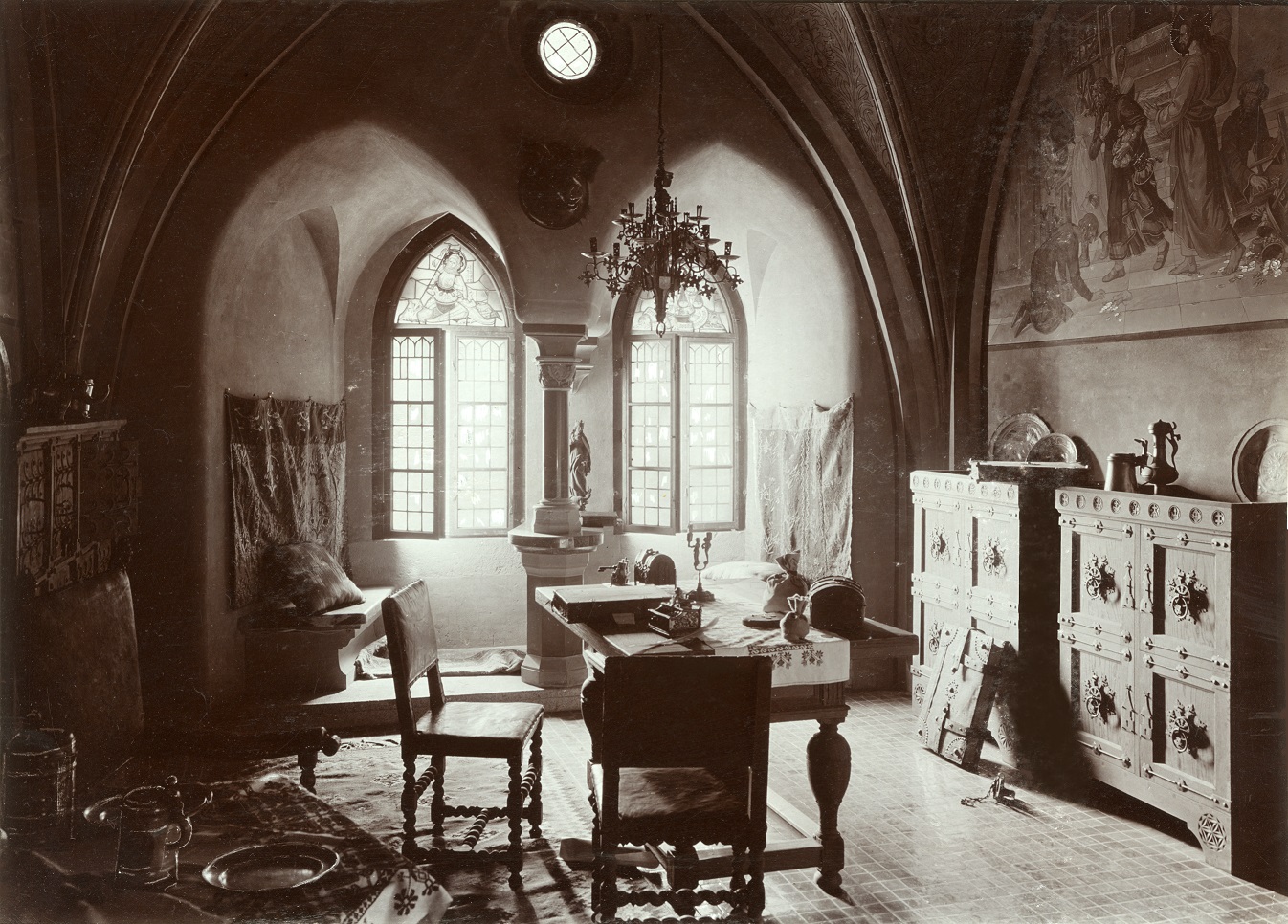Franz Lauterbach
Place of origin: Hanover
Time of creation: 1903
Technique: painting
Material: glass, lead, paints
Dimensions: height 70 cm, base width 67 cm
Signatures: none
Pre-war inventory number: unknown
Date of loss: 1945 (or shortly after)
Stained glass window from St. George – left window of the Tresler’s Chamber in the complex of chambers of dignitaries of the Order at the High Castle
Glazing composed of 39 different sizes and shapes, painted panes, joined with lead. A compositional format that fits into an isosceles triangle, embedded in a wooden frame, matched to the pointed closure of the window quarter. The figural centered composition, described on an isosceles triangle, shows a figure set on an ornamental base from the waist upwards. Decorative element composed of acanthus leaves and a horizontally arranged dragon silhouette. Opaque, monochromatic background (probably off-white). In the left part, enclosed in a vertical rectangular frame, written in a Gothic font, one word German inscription: St/Ju/rg/en [St. George]. Briefly shown 3/4 figure of the knight Jerzy, turned to the left, slightly tilted back. The right hand, raised above his head, holds the spear pointing downwards by the end of the spar. Left hand bent at the elbow, placed on the breastplate at the level of the heart. Face with stubble, visible from under the hood of a chain surrounded by a halo. A coat on the shoulders, gloves and epaulettes on the hands. A dragon laid flat on his back, with an open toothed mouth into which the blade of a spear enters. One of the dragon wings visible captures the base on which George is mounted. The tail wraps behind the leaves of the acanthus, the dragon’s paws raised upwards, at the height of the knight’s elbow.
Stained glass window with Archangel Michael – right window of the Tresler’s Chamber in the complex of chambers of dignitaries of the Order at the High Castle
Glazing composed of 29 different sizes and shapes of painted panes, joined with lead. A compositional format that fits into an isosceles triangle, embedded in a wooden frame, matched to the pointed closure of the window quarter. The figural centered composition, described on an isosceles triangle, shows a half-figure set on an ornamental base from the waist upwards. A decorative element consisting of acanthus leaves and a horizontally arranged band, on which three Latin words are written in Gothic font: Perpen/do vitia virtusque [I weigh sins and virtues]. Opaque, monochromatic background (probably off-white). The figure of the Archangel is shown, with youthful facial features and thick, semi-long hair, surrounded by a halo. Turned to the left, in a nutshell. Wings folded close to the body, visible above the halo and shoulders. Above the forehead there is a diadem with one post ending with an oval medallion. In the right hand a sword raised up, in the left a two-armed scale with hemispherical plates.
Both stained glass windows were framed in mobile, easy to subtract and quite handy frames, installed to frame the window openings from the interior with movable iron handles. It can therefore be presumed that they were taken in consultation with the authorities of the Polish Army Museum and the Malbork poviat, perhaps by Catholic priests looking for ready-made elements that could be used to equip churches damaged during the war. However, an act of simple looting cannot be ruled out. However, the possibility of destroying these two stained glass windows during the fights in February and March 1945 can be considered unlikely. Due to the location of the windows of the tresler’s chamber, on the west side of the High Castle, even such fragile and delicate elements of equipment were not damaged as a result of military operations. They brought the most damage to the eastern parts of the castle.
Post-war literature mistakenly identifies one of the representations as an allegory of Justice or a “female figure with weight” [Witkowicz-Pałka 2001, Dory 2006]. It is worth noting, however, how the sophisticated selection of iconographic themes of these glazing combined the threads of the knightly ethos and the official function of the room for which they were intended. Both depictions show the most archetypal knightly figures of the Middle Ages. The commander of the heavenly hosts and George were symbols of the fight between good and evil and figures of an ideal Christian warrior. Such features were projected by the knights of the Order of the Blessed Virgin Mary – this is how they were perceived by historians and conservators of Kaizerzeit. In addition, both divine fighters belonged to the canon of patrons especially revered in chivalric orders. The attribute of the treasurer, who was a high government official responsible for finances, was the weight – shown in the quarters with the Archangel. The motifs: weight, money, weighing good and sins, all those elements that in the Old and New Testament combined economic motifs with the economy of salvation, were abundantly introduced into the iconographic program of the chambers of dignitaries (especially in the wall paintings heavily damaged today), in which both stained glass windows were harmoniously inscribed. Today, in their place are reconstructed frames filled with sheets of transparent glass, joined with lead. The grid of connections partially repeats the arrangement of lost compositions, showing their outline quite clearly.
(edited by B. Butryn)



